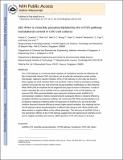28S rRNA is inducibly pseudouridylated by the mTOR pathway translational control in CHO cell cultures
Author(s)
Courtes, Franck C.; Gu, Chen; Wong, Niki S.C.; Dedon, Peter C.; Yap, Miranda G.S.; Lee, Dong-Yup; ... Show more Show less
DownloadDedon_28s rRNA.pdf (995.6Kb)
PUBLISHER_CC
Publisher with Creative Commons License
Creative Commons Attribution
Terms of use
Metadata
Show full item recordAbstract
The mTOR pathway is a conserved master regulator of translational activity that influences the fate of industrially relevant CHO cell cultures, yet its molecular mechanisms remain unclear. Interestingly, rapamycin specific inhibition of the mTOR pathway in CHO cells was found to down-regulate the small nucleolar RNA U19 (snoRNA U19) by 2-fold via translatome profiling. snoRNA U19 guides the two most conserved pseudouridylation modifications on 28S ribosomal RNA (rRNA) that are important for the biogenesis and proper function of ribosomes. In order to further understand the role of snoRNA U19 as a potential player in the mTOR pathway, we measured 28S rRNA pseudouridylation upon rapamycin treatments and/or snoRNA U19 overexpression conditions, thereby characterizing the subsequent effects on ribosome efficiency and global translation by polysome profiling. We showed that 28S rRNA pseudouridylation was increased by rapamycin treatment and/or overexpression of snoRNA U19, but only the latter condition improved ribosome efficiency toward higher global translation, thus implying that the mTOR pathway induces pseudouridylation at different sites along the 28S rRNA possibly with either positive or negative effects on the cellular phenotype. This discovery of snoRNA U19 as a new downstream effector of the mTOR pathway suggests that cell engineering of snoRNAs can be used to regulate translation and improve cellular growth in CHO cell cultures in the future.
Date issued
2014-01Department
Massachusetts Institute of Technology. Center for Environmental Health Sciences; Massachusetts Institute of Technology. Department of Biological EngineeringJournal
Journal of Biotechnology
Publisher
Elsevier
Citation
Courtes, Franck C., Chen Gu, Niki S.C. Wong, Peter C. Dedon, Miranda G.S. Yap, and Dong-Yup Lee. “28S rRNA Is Inducibly Pseudouridylated by the mTOR Pathway Translational Control in CHO Cell Cultures.” Journal of Biotechnology 174 (March 2014): 16–21.
Version: Author's final manuscript
ISSN
01681656